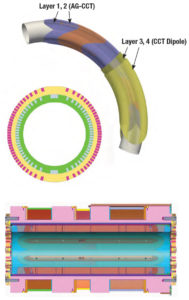Interest in the next generation of hadron colliders as one of the main discovery tools for the future of high-energy physics has been evolving rapidly. There are growing activities toward development of machine designs at CERN (Future Circular Collider — FCC),1 encouraged by the 2013 EU Strategy Update, and in China (Super proton-proton Collider — SppC).2 In the US, the recent Particle Physics Project Prioritization Panel (P5) has strongly supported a future high-energy proton-proton collider as part of an overall strategy.
Subsequently, the DOE Office of High Energy Physics commissioned a High Energy Physics Advisory Panel (HEPAP) subpanel4 to advise on medium and long term national goals for US Accelerator R&D in accelerator based particle physics consistent with the P5 report.
The P5 report states, “A very high-energy proton-proton collider is the most powerful future tool for direct discovery of new particles and interactions under any scenario of physics results that can be acquired in the P5 time window.” The report also states, “The U.S. is the world leader in R&D on high-field superconducting magnet technology, which will be a critical enabling technology for such a collider.” In light of these observations, the P5 strategic plan endorses medium-term R&D on high-field magnets and materials in the context of its recommendation 24: “Participate in global conceptual design studies and critical path R&D for future very high-energy proton-proton colliders. Continue to play a leadership role in superconducting magnet technology focused on the dual goals of increasing performance and decreasing costs.”
The Subpanel strongly supported this direction through a number of specific recommendations.
 Click for larger version |
Enabling technologies that have benefits far beyond their origins Superconducting medical gantry magnet (top left), an HEP Stewardship project performed in close collaboration with a US industrial partner; electron cyclotron resonance magnet (bottom left) for the Facility for Rare Isotope Beams (FRIB), a nuclear-science user facility being built at Michigan State University; Nb3Sn superconducting undulator (top right), developed in collaboration with Argonne National Laboratory and SLAC National Accelerator Laboratory; and a high-field tokamak concept for fusion energy (bottom right) are examples of how the investment in USMDP research provides leveraged benefits for other agency and national needs. |
 Click for larger version |
||
The USMDP is an ambitious, internationally competitive program to develop accelerator magnets with operating fields that exceed existing LHC dipole magnets at least by a factor of two while substantially reducing the cost per tesla-meter. It will reassert U.S. leadership in high field accelerator magnet technology by aggressively pushing the limits of magnets and materials to extreme levels of performance.
On this website we describe the guiding vision; the specific goals; the general plan and scope of work; a preliminary estimate of the resources necessary to carry out the work within a reasonable schedule; and a management plan to guide the work, measure progress and make program adjustments. Executing the plan put forth here, we will advance high-energy physics while increasing our own capabilities in accelerator magnet technology that will position the U.S. to be able to lead in the development of enabling technology for the next generation of very high energy proton-proton colliders or, in the nearer term, establish a technology base for a possible energy upgrade of the LHC.
As an HEP funded Program, the primary focus is on magnets for accelerators, but the generic approach will develop magnet technologies that can be applied to a large variety of applications. These include: low-temperature and high-temperature superconducting magnets for particle beam therapy,5 high field magnet systems for electron cyclotron resonance (ECR) ion sources,6, 7 superconducting undulators to improve the performance of light sources, very high field high-temperature-superconductor (HTS) magnets for future fusion reactors,8 and research magnets as described in the recent MagSci Report.9
References
1 Future Circular Collider Study Kickoff Meeting (University of Geneva, February 12-14, 2014).
2 Yifang Wang, “Introduction to CEPC/SppC.”
3 Building for Discovery: Strategic Plan for U.S. Particle Physics in the Global Context, the Particle Physics Project Prioritization Panel (P5) Report.
4 Accelerating Discovery: A Strategic Plan for Accelerator R&D in the U.S. (HEPAP Accelerator R&D Subpanel Report, April 2015).
5 W. Wan, L. Brouwer, S. Caspi, S.O. Prestemon, A. Gerbershagen, J.M. Schippers, and D. Robin, “Alternating-Gradient Canted Cosine Theta Superconducting Magnets For Future Compact Proton Gantries,” Physical Review Special Topics — Accelerators and Beams 18, 10 (October 2015), 103501.
6 H. Felice et al., “Design of a Superconducting 28 GHz Ion Source Magnet for FRIB Using a Shell-Based Support Structure,” IEEE Transactions on Applied Superconductivity 25, 3 (2015), pp. 1–5.
7 C. Lyneis, D. Leitner, D. S. Todd, G. Sabbi, S. Prestemon, S. Caspi and P. Ferracin, “Fourth Generation Electron Cyclotron Resonance Ion Sources (invited),” Review of Scientific Instruments 79, 2 (2008), 02A321.
8 D.G. Whyte, J. Minervini, B. LaBombard, E. Marmar, L. Bromberg, and M. Greenwald, “Smaller & Sooner: Exploiting High Magnetic Fields from New Superconductors for a More Attractive Fusion Energy Development Path,” Journal of Fusion Energy 35, 1 (22 January 2016), pp. 41–53.
9 High Magnetic Field Science and Its Application in the United States: Current Status and Future Directions (National Academies Press, 2013).
